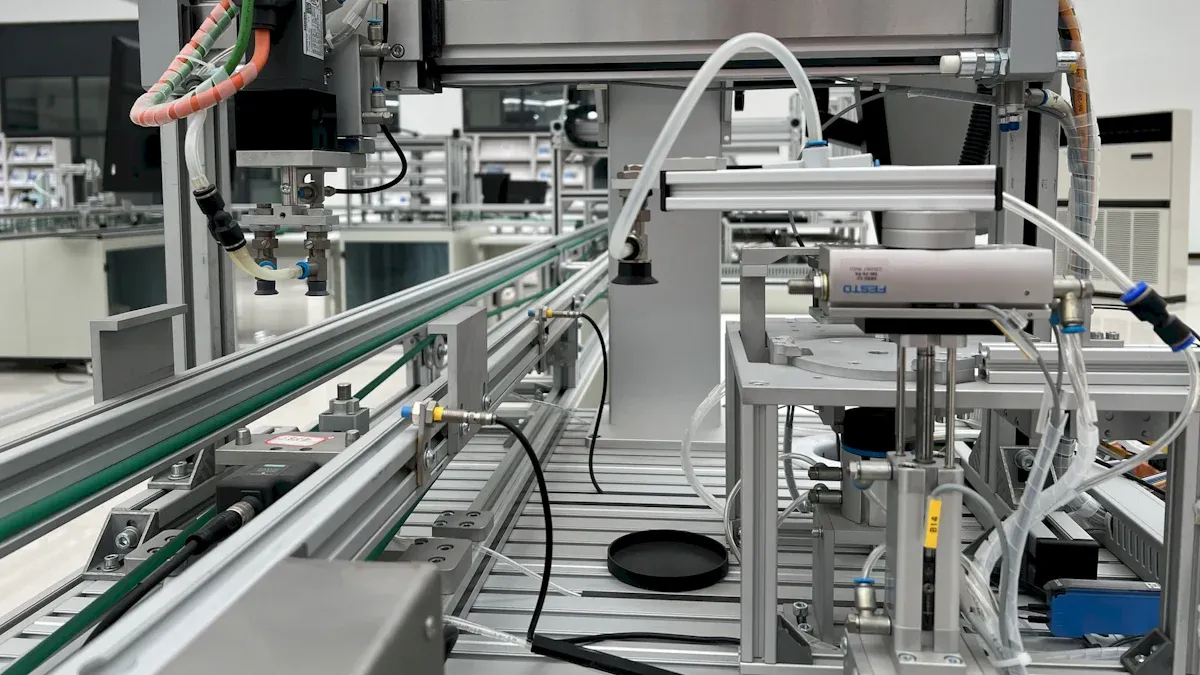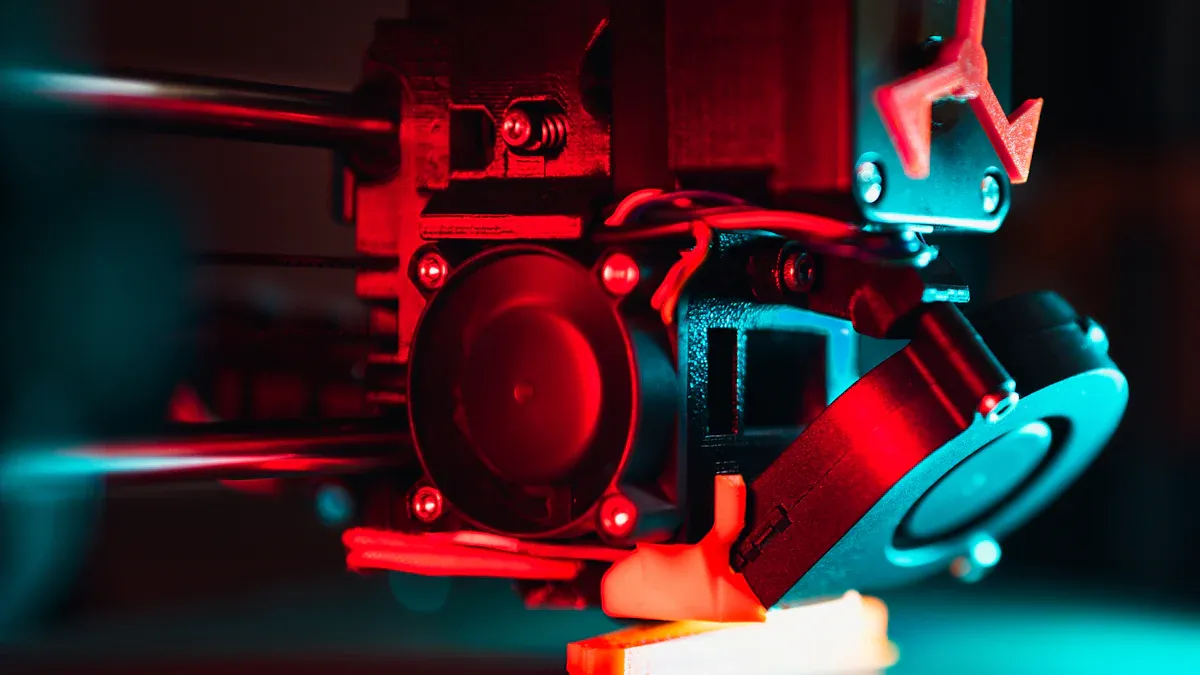
Conical twin screws are essential in PVC pipe production, where precision and efficiency are critical. The global demand for these specialized components, including conical twin screw for PVC pipe, underscores their significance.
- The Counter Rotating Twin-screw Extruder Market is projected to expand from USD 1.2 billion in 2024 to USD 2.5 billion by 2033, with an impressive 8.9% CAGR.
- The surge in construction material production, particularly in the Asia-Pacific region, drives this increasing demand.
Modern innovations, such as PVC conical screws, improve material homogeneity and minimize shear rates, ensuring stable extrusion. These advancements cater to the growing need for high-performance solutions in PVC pipe production parallel twin screw systems, including twin parallel screw barrels.
Overview of Conical Twin Screw For PVC Pipe
Design and Functionality
Conical twin screw extruders play a pivotal role in PVC pipe production by enhancing material processing efficiency. Their design focuses on achieving superior mixing and homogenization, which are critical for producing high-quality pipes. These systems compress and melt raw materials, ensuring consistent plasticization. The screws feature optimized configurations, including precise control of temperature and pressure, to maintain uniformity in the final product.
Operationally, the conical twin screw design emphasizes controlled screw speed and torque distribution. This ensures effective dispersion of additives, resulting in uniform color and dimensional stability. The ability to handle high-output applications while maintaining product quality makes these extruders indispensable in modern manufacturing.
Applications in PVC Pipe Manufacturing
Conical twin screw systems cater to diverse requirements in PVC pipe production. Their adaptability allows manufacturers to adjust barrel diameters, optimizing output rates and melt quality. Modern control systems integrated into these extruders regulate temperature, pressure, and speed, ensuring consistent results.
| Application Aspect | Description |
|---|---|
| Adjustment of Barrel Diameter | Optimizing screw diameter enhances output rates and melt quality, tailored for PVC pipe needs. |
| Integration of Modern Control Systems | Modern controls manage temperature, pressure, and speed, ensuring consistent product quality. |
| Monitoring during Production | Close monitoring of process conditions aids in producing high-quality PVC pipes. |
These features make conical twin screws a reliable choice for manufacturers aiming to meet stringent quality standards.
Advantages of the Conical Design
The conical design offers several advantages over traditional screw systems. It ensures uniform plasticization and mixing, which are essential for consistent product quality. The design supports high-output production, making it suitable for large-scale operations.
| Benefit/Advantage | Description |
|---|---|
| Uniform plasticization and mixing | Ensures consistent quality in the final product. |
| High output | Capable of producing larger quantities of extruded material efficiently. |
| Stable quality | Maintains product quality over time, reducing variability. |
| Wide adaptability | Can process a variety of thermoplastics, especially hard PVC powder. |
| Long service life | Designed for durability, leading to lower replacement costs. |
| Direct molding of PVC powder | Allows for immediate production of plastic products without additional processing steps. |
| Good plasticizing performance | Effectively melts and mixes materials for optimal extrusion. |
| Good extrusion force | Capable of handling high pressures during the extrusion process. |
These benefits highlight why the conical twin screw for PVC pipe remains a preferred choice for manufacturers worldwide. Its ability to deliver consistent performance, durability, and adaptability ensures its relevance in 2025 and beyond.
Features and Specifications Driving Efficiency

Plasticizing Performance and Material Homogeneity
The plasticizing performance of conical twin screws ensures that PVC materials are melted and mixed uniformly. This process is critical for producing pipes with consistent quality and structural integrity. The advanced screw design enhances material homogeneity by extending the effective screw length, which reduces reject rates and improves overall production efficiency.
Tip: Homogeneous material mixing minimizes defects in the final product, ensuring pipes meet stringent industry standards.
The integration of direct torque control further optimizes plasticization. By maintaining constant screw RPM, this feature reduces output variations and material wastage. Additionally, internal screw cooling systems provide precise temperature control, which enhances the quality of the melt and ensures consistent extrusion results.
| Feature | Benefit |
|---|---|
| High Production Capacity | Enables large quantities of pipes to be produced quickly, meeting deadlines without sacrificing quality. |
| Improved Screw Design | Results in a longer effective screw length, producing a more homogeneous melt and reducing reject rates. |
| Direct Torque Control | Ensures constant screw RPM, minimizing output quality variations and reducing wastage. |
| Internal Screw Cooling | Provides precise control over melt temperature, improving pipe quality and ensuring consistent output. |
Energy Efficiency and Power Optimization
Energy efficiency is a key factor in modern PVC pipe extrusion. Conical twin screws excel in this area by incorporating energy-efficient drive systems. These systems deliver exceptional performance while consuming less power, reducing operational costs and environmental impact.
The optimized screw geometry minimizes energy loss during the extrusion process. This design ensures that the mechanical energy is effectively converted into thermal energy, which is essential for melting PVC materials. Furthermore, the ability to operate at lower temperatures reduces energy consumption without compromising the quality of the final product.
Note: Energy-efficient systems not only lower costs but also align with global sustainability goals, making them a preferred choice for manufacturers.
Adaptability to PVC Formulations and Pipe Sizes
Conical twin screws demonstrate remarkable versatility in handling various PVC formulations and pipe sizes. Their design accommodates variations in bulk density, acting as a quasi-positive displacement gear pump. This capability ensures consistent output rates, even when the density of the PVC resin changes.
Manufacturers benefit from features like adjustable screw cores and gearbox designs, which allow for different motor positions. Barrel tempering systems offer flexibility by covering a wide range of outputs, making these screws suitable for diverse production requirements.
| Feature | Description |
|---|---|
| Screw Core | Fits all screw tempering systems. |
| Gearbox Design | Allows several different motor positions (U or Z version). |
| Barrel Tempering Systems | Processors can choose between different systems, covering a wide range of outputs. |
| Process Pressure Capability | Can work with pressures up to 520 bar (7500 psi), suitable for small or thin-walled profiles. |
| Quick Cleaning | Minimized residence times enable faster color changes, saving material. |
Additionally, conical twin screws consume less power compared to single screw extruders for the same output rates. This efficiency, combined with their adaptability, makes them an ideal choice for manufacturers aiming to produce high-quality PVC pipes in varying sizes and formulations.
Advancements in Conical Twin Screw Design for 2025

Innovations in Screw Materials and Geometry
Recent advancements in screw materials and geometry have revolutionized the performance and durability of conical twin screws. Manufacturers are leveraging cutting-edge technologies to enhance the efficiency and adaptability of these components. Key innovations include:
- The use of advanced materials that are lighter, more durable, and resistant to corrosion, ensuring longer service life and reduced maintenance costs.
- Integration of smart technologies for real-time monitoring and adjustments during production, improving overall process control.
- Adoption of 3D printing technology for rapid prototyping and production of complex geometries, which has the potential to reduce manufacturing costs by up to 90%.
- Modular designs that allow for greater customization, enabling manufacturers to meet diverse production requirements with ease.
These advancements not only improve the performance of conical twin screws but also align with the growing demand for sustainable and cost-effective manufacturing solutions. By incorporating these innovations, manufacturers can achieve higher output rates and better product quality, making the conical twin screw for PVC pipe a preferred choice in the industry.
Integration of Smart Control Systems
The integration of smart control systems into conical twin screw designs has significantly enhanced production monitoring and efficiency. Intelligent process monitoring systems now utilize advanced measurement technologies and AI models to optimize extrusion processes. These systems analyze disturbance variables in real time, providing inline measurement visualization through user-friendly dashboards.
For example, retrofitting existing screw presses with intelligent monitoring technology has demonstrated remarkable improvements in performance. By employing structured development models like CRISP-DM, manufacturers can identify and address inefficiencies in the production process. This approach ensures consistent output quality while minimizing material waste.
Smart control systems also enable precise adjustments to temperature, pressure, and screw speed, ensuring optimal plasticization and material homogeneity. These features make modern conical twin screws indispensable for manufacturers aiming to meet stringent quality standards in PVC pipe production.
Industry Trends Shaping Future Designs
The future of conical twin screw designs is being shaped by several key industry trends. These trends reflect the evolving demands of manufacturers and consumers, as well as advancements in technology and sustainability.
| Trend | Impact on Conical Twin Screw Designs |
|---|---|
| Sustainability | Increased demand for biodegradable materials, leading to design adaptations for processing eco-friendly polymers. |
| Automation | Integration of advanced machinery to optimize production lines, enhancing throughput and product quality. |
| Customization | Modular design allows for quick adjustments in processing parameters, catering to unique consumer preferences. |
| Digitalization | Enhanced data analytics for real-time performance monitoring, improving decision-making and production transparency. |
| Market Growth | Projected CAGR of over 6% in the next five years, driven by investments in R&D for performance and sustainability. |
These trends highlight the importance of innovation and adaptability in the design of conical twin screws. By embracing these shifts, manufacturers can stay ahead of the competition and meet the growing demand for high-quality PVC pipes.
Conical twin screws remain vital in PVC pipe extrusion, ensuring efficiency and quality. Their advanced features, such as energy optimization and material adaptability, drive industry innovation. Recent advancements in smart systems and sustainable designs position them as indispensable tools. These screws will continue shaping the future of high-performance PVC manufacturing.
FAQ
What makes conical twin screws ideal for PVC pipe extrusion?
Conical twin screws provide superior plasticization, consistent material mixing, and high output. Their adaptability to various PVC formulations ensures efficient and high-quality pipe production.
How do smart control systems improve extrusion processes?
Smart control systems optimize temperature, pressure, and screw speed. They enhance material homogeneity, reduce waste, and ensure consistent product quality through real-time monitoring and adjustments.
Why is energy efficiency important in conical twin screw designs?
Energy-efficient designs lower operational costs and environmental impact. Optimized screw geometry and advanced drive systems reduce energy consumption while maintaining high extrusion performance.
Post time: Apr-24-2025
